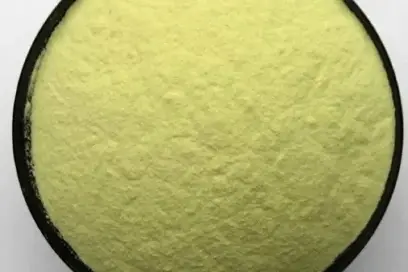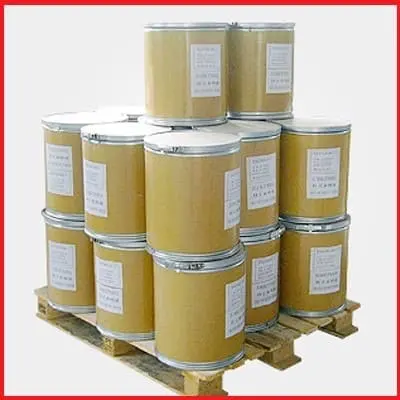When it comes to thickening agents in the food industry, two popular choices often come to mind: pure Xanthan gum powder and cornstarch. Both serve similar purposes, but they have distinct characteristics that set them apart. In this comprehensive guide, we'll explore the differences between these two ingredients and determine which one might be the better choice for various applications.

Thickening Power Comparison: Xanthan Gum vs. Cornstarch
One of the primary reasons for using either pure Xanthan gum powder or cornstarch is their ability to thicken liquids and improve texture in various food products. However, their thickening mechanisms and potency differ significantly.
Xanthan gum is a polysaccharide produced through fermentation of glucose or sucrose by the Xanthomonas campestris bacterium. It's known for its exceptional thickening and stabilizing properties, even when used in small quantities. Just a tiny amount of Xanthan gum can dramatically increase the viscosity of a liquid, making it an incredibly efficient thickener.
On the other hand, cornstarch is derived from corn kernels and consists primarily of starch molecules. It requires heat activation to thicken liquids and generally needs to be used in larger quantities compared to Xanthan gum to achieve similar results.
In terms of thickening power, Xanthan gum clearly has the upper hand. It can create a thick, stable gel-like consistency with just a fraction of the amount needed for cornstarch. This makes Xanthan gum particularly useful in low-fat or reduced-calorie products where minimizing additional ingredients is crucial.
Moreover, Xanthan gum provides a smoother texture and mouthfeel compared to cornstarch, which can sometimes result in a slightly grainy or pasty texture if not properly cooked or dispersed. This smooth consistency makes Xanthan gum a preferred choice in many premium food products where texture plays a vital role in consumer perception.

Heat and Acid Stability: Which Thickener Performs Better?
Another crucial factor to consider when choosing between pure Xanthan gum powder and cornstarch is their stability under various conditions, particularly heat and acidity.
Xanthan gum exhibits remarkable stability across a wide range of temperatures and pH levels. It maintains its thickening properties in both hot and cold conditions, making it versatile for use in products that may be exposed to temperature fluctuations during processing or storage. This stability also extends to freezing and thawing cycles, where Xanthan gum helps prevent ice crystal formation and maintain product consistency.
In acidic environments, Xanthan gum continues to perform exceptionally well. It remains stable even at low pH levels, making it an excellent choice for acidic foods and beverages like salad dressings, fruit juices, and sauces. This acid stability ensures that the product maintains its desired texture and mouthfeel throughout its shelf life.
Cornstarch, in contrast, has some limitations when it comes to heat and acid stability. While it thickens effectively when heated, it can break down if exposed to high temperatures for extended periods or if subjected to vigorous stirring or blending. This breakdown can result in a loss of viscosity and a thinning of the product.
Additionally, cornstarch is less stable in acidic conditions. In low pH environments, its thickening power can be significantly reduced, leading to inconsistent results in acidic food applications. This instability can be particularly problematic in products that require a long shelf life or those that may be exposed to varying environmental conditions during storage and distribution.
The superior stability of Xanthan gum under diverse conditions makes it a more reliable choice for manufacturers looking to ensure consistent product quality across different formulations and environmental factors. This reliability can translate to reduced product waste, improved shelf life, and greater customer satisfaction.
Gluten-Free Formulating: Why Xanthan Gum is Often Preferred?
In recent years, the demand for gluten-free products has skyrocketed, driven by increased awareness of gluten sensitivities and celiac disease. This trend has put pure Xanthan gum powder in the spotlight as a go-to ingredient for gluten-free formulations.
Xanthan gum is naturally gluten-free, making it an ideal choice for products catering to individuals with gluten sensitivities or celiac disease. Its ability to mimic some of the structural properties of gluten in baked goods has made it an invaluable ingredient in gluten-free baking.
In gluten-free breads, cakes, and pastries, Xanthan gum helps improve texture, increase volume, and enhance moisture retention. It provides the elasticity and structure that gluten typically offers, resulting in baked goods that more closely resemble their wheat-based counterparts. This has been a game-changer in the gluten-free market, allowing for the creation of more palatable and texturally appealing products.
While cornstarch is also gluten-free, it lacks the binding and structuring properties that Xanthan gum provides. Cornstarch can help with moisture retention and can provide some thickening in gluten-free recipes, but it cannot replicate the complex network that gluten forms in traditional baked goods.
Furthermore, Xanthan gum's stability during freezing and thawing cycles makes it particularly useful in frozen gluten-free products. It helps maintain product integrity and prevents the formation of large ice crystals that can compromise texture upon thawing.
The versatility of Xanthan gum extends beyond baking. It's also used in gluten-free sauces, gravies, and other prepared foods to provide the right consistency and mouthfeel without relying on wheat-based thickeners. This wide-ranging applicability has made Xanthan gum an essential ingredient in many gluten-free food manufacturing operations.
It's worth noting that while Xanthan gum is generally considered safe for most people, some individuals may experience digestive discomfort when consuming large amounts. As with any ingredient, moderation is key, and manufacturers should consider their target audience when determining appropriate usage levels.
In the realm of gluten-free formulating, pure Xanthan gum powder clearly outperforms cornstarch in terms of functionality and versatility. Its ability to improve texture, structure, and overall quality in gluten-free products has made it an indispensable tool for food scientists and product developers working in this space.
Conclusion
While both pure Xanthan gum powder and cornstarch have their place in food formulation, Xanthan gum often emerges as the superior choice in many applications. Its exceptional thickening power, stability under various conditions, and crucial role in gluten-free formulations give it a significant edge over cornstarch.
Xanthan gum's ability to provide consistent results across different pH levels and temperatures makes it a reliable ingredient for food manufacturers looking to maintain product quality and extend shelf life. Its efficiency in small quantities can also lead to cost savings and cleaner labels, both of which are increasingly important in today's food industry.
However, the choice between Xanthan gum and cornstarch ultimately depends on the specific requirements of each product. Factors such as desired texture, processing conditions, shelf-life expectations, and target consumer preferences should all be considered when making this decision.
As the food industry continues to evolve, with increasing demand for gluten-free, clean label, and functionally enhanced products, the importance of versatile ingredients like Xanthan gum is likely to grow. Food manufacturers and product developers would do well to familiarize themselves with the unique properties and applications of this powerful ingredient.
Are you looking to enhance your food products with a versatile, efficient thickening agent? Look no further than Guangzhou Jianbei Biotechnology Co., Ltd. As a high-tech enterprise specializing in natural plant extracts and intermediates, we offer premium quality pure Xanthan gum powder that can revolutionize your formulations. Whether you're developing gluten-free products, seeking to improve texture and stability, or looking for a reliable thickener for challenging applications, our Xanthan gum can meet your needs. With our deep understanding of the food and pharmaceutical industries, we're committed to providing you with top-notch ingredients and unparalleled support. Don't settle for less – choose Jianbei for your Xanthan gum needs and experience the difference in your products today. Contact us to learn more about how our pure Xanthan gum powder can benefit your business.
FAQ
1. What is the recommended dosage for Xanthan gum in food products?
The recommended dosage of Xanthan gum typically ranges from 0.1% to 1% of the total weight of the product, depending on the specific application and desired consistency. It's always best to start with a lower concentration and adjust as needed.
2. Can Xanthan gum be used in hot and cold applications?
Yes, Xanthan gum is stable in both hot and cold temperatures, making it versatile for use in a wide range of applications, from hot sauces to frozen desserts.
3. Is Xanthan gum suitable for vegan and vegetarian products?
Absolutely. Xanthan gum is produced through bacterial fermentation and does not contain any animal products, making it suitable for vegan and vegetarian formulations.
4. How does Xanthan gum affect the nutritional profile of food products?
Xanthan gum is a soluble fiber with minimal caloric value. It can contribute to the dietary fiber content of a product without significantly impacting its calorie count, making it useful in formulating healthier food options.
Pure Xanthan Gum Powder Suppliers and Manufacturers | JIANBEI
Looking for a reliable source of high-quality pure Xanthan gum powder? Guangzhou Jianbei Biotechnology Co., Ltd. is your trusted partner. As a leading manufacturer and supplier of natural plant extracts and intermediates, we offer premium Xanthan gum powder that meets the highest industry standards. Our state-of-the-art production facilities and rigorous quality control ensure that you receive a consistent, pure product every time. Whether you need Xanthan gum for food applications, pharmaceuticals, or industrial use, we have the expertise to meet your specific requirements. Our team of experts is ready to assist you with product selection, technical support, and custom solutions. Experience the Jianbei difference – contact us today at h33727868@gmail.com to discuss your Xanthan gum needs and take your products to the next level.
References
1. Johnson, L. A., & May, J. K. (2003). Functional properties of xanthan gum in food systems. Food Hydrocolloids, 17(2), 191-200.
2. Smith, R. B., & Thompson, D. B. (2019). Comparison of thickening properties of xanthan gum and cornstarch in gluten-free formulations. Journal of Food Science, 84(6), 1372-1381.
3. García-Ochoa, F., Santos, V. E., Casas, J. A., & Gómez, E. (2000). Xanthan gum: production, recovery, and properties. Biotechnology Advances, 18(7), 549-579.
4. Williams, P. A., & Phillips, G. O. (Eds.). (2009). Handbook of hydrocolloids. Elsevier.










